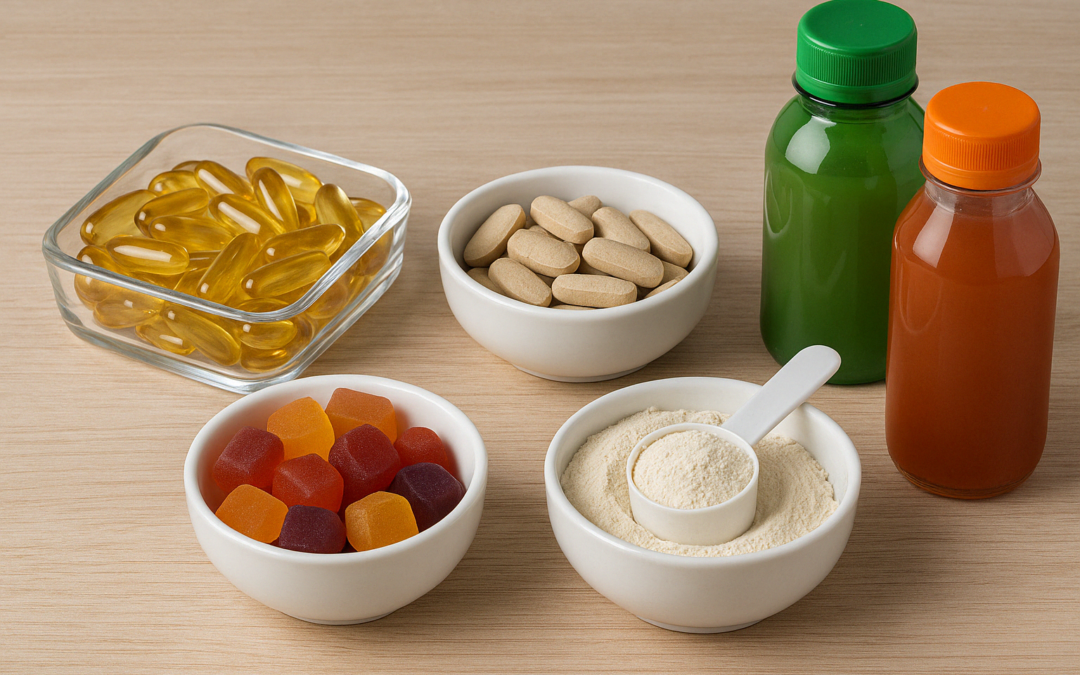As the demand for dietary supplements and functional foods continues to rise, brands consistently innovate with various delivery formats to enhance efficacy, convenience, and consumer appeal. The choice of format significantly influences absorption, stability, and user compliance. Below, we examine the most common delivery forms, their benefits, and their potential associated challenges.
Capsules and Softgels
Why They’re Good:
- Convenience: Easy to swallow and dose precisely.
- Shelf Stability: Longer shelf life compared to liquids or gummies.
- Masking Taste & Odor: Encapsulation can hide unpleasant tastes and smells, especially for fish oils and botanicals.
- Controlled Release Options: Some capsules offer delayed or extended-release mechanisms for better absorption.
Hurdles:
- Swallowing Difficulty: Some people, especially children and older adults, have difficulty swallowing pills.
- Slower Absorption: Compared to liquid forms, capsules take longer to dissolve in the digestive system.
- Pill Fatigue: Many consumers are becoming weary of taking more pills.
- Ingredient Limitations: Some compounds (e.g., probiotics and certain enzymes) require specialized encapsulation techniques to maintain efficacy.
Tablets
Why They’re Good:
- Compact & Cost-Effective: Cheaper to produce and can hold a high concentration of active ingredients.
- Controlled Disintegration: Some tablets dissolve quickly, while others offer extended-release formulations.
- Customizable: Can be coated to mask taste or make them easier to swallow.
Hurdles:
- Compressibility Issues: Some ingredients, especially herbs and enzymes, are difficult to compress into stable tablets.
- Absorption Delays: Hard tablets can take longer to break down in the stomach, affecting bioavailability.
- Taste Concerns: Some tablets may still have a chalky or bitter taste even with coatings.
Powders
Why They’re Good:
- High Dose Capacity: Ideal for ingredients that require larger doses (e.g., protein, collagen, greens).
- Rapid Absorption: No need for breakdown in the stomach, allowing for quicker utilization by the body.
- Versatility: Can be mixed with water, smoothies, or functional foods.
Hurdles:
- Taste & Texture Issues: Some powders have an unpleasant taste or gritty texture, making them harder to consume.
- Mixability Problems: Some ingredients clump or fail to dissolve well in liquids.
- Portability: Less convenient for on-the-go consumers compared to capsules or ready-to-drink options.
Gummies
- Why They’re Good:
- Great Taste & Appeal: Popular among children and adults who dislike pills.
- Easy Compliance: Fun and enjoyable to take daily.
- Good for Fat-Soluble Nutrients: Can be formulated with fats for improved absorption of vitamins like D and E.
Hurdles:
- Sugar Content: Many gummies contain added sugars, which may not appeal to health-conscious consumers.
- Limited Active Ingredient Load: Cannot carry as many active compounds as capsules or powders.
- Stability Issues: Sensitive to heat and moisture, leading to melting or degradation over time.
Liquids
Why They’re Good:
- Fast Absorption: Bypasses the need for digestion, leading to quicker uptake into the bloodstream.
- Customizable Dosing: Dropper bottles allow for precise and flexible dosing.
- Good for Sensitive Populations: Ideal for children, elderly individuals, or those with digestive issues.
Hurdles:
Shorter Shelf Life: More prone to oxidation and microbial growth than dry forms.
- Taste Challenges: Some liquid supplements have strong, bitter, or unpleasant flavors.
- Bulk & Portability: Liquid bottles are bulkier and less convenient for travel than pills or powders.
Functional Foods (Bars, Chews, etc.)
Why They’re Good:
- Dual Purpose: Provide both nutrition and supplementation in one product.
- Convenience: Easy to consume as a snack while delivering functional benefits.
- Better Taste & Enjoyment: More appealing than taking pills or powders.
Hurdles:
- Formulation Challenges: It is hard to maintain the stability of active ingredients like probiotics, omega-3s, and vitamins.
- Caloric & Sugar Concerns: Some bars and chews contain high amounts of sugar, fats, or artificial additives.
- Shelf Stability: Moisture content can impact the longevity of the product.
Functional Beverages (RTDs, Shots, Effervescent Tablets)
Why They’re Good:
- High Bioavailability: Liquids allow for faster absorption compared to pills.
- Enhanced Consumer Experience: Can be flavored for better taste and engagement.
- Hydration Benefits: Helps meet fluid intake needs while delivering nutrients.
Hurdles:
- Stability Issues: Some vitamins and probiotics degrade in liquid form over time.
- Storage Requirements: Many functional drinks need refrigeration.
- Packaging & Cost: More expensive due to packaging and logistics.
Choosing the Right Format: Key Considerations
Selecting the best delivery format depends on several factors:
- Target Consumer: Children, elderly, or those with difficulty swallowing prefer gummies or liquids.
- Ingredient Stability: Sensitive compounds like probiotics and omega-3s require special formulations.
- Convenience & Compliance: Portable options like capsules, tablets, or RTD beverages enhance adherence.
- Bioavailability Needs: Liquids, powders, and functional foods often offer faster absorption.
No single delivery format is perfect for every ingredient or consumer. The best choice relies on balancing efficacy, stability, taste, convenience, and cost. As innovation in supplement and functional food technology progresses, we can anticipate more creative and effective methods to deliver essential nutrients for improved health and wellness.


